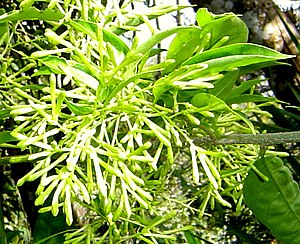Dama da Noite
| Dama da Noite | ||||||||||||
|---|---|---|---|---|---|---|---|---|---|---|---|---|

Dama da Noite ( Cestrum laevigatum ) |
||||||||||||
| Systematics | ||||||||||||
|
||||||||||||
| Scientific name | ||||||||||||
| Cestrum laevigatum | ||||||||||||
| Schltdl. |
The Dama da Noite [ ˌdamɐ da ˈnoi̯t͡ʃi ] ( Cestrum laevigatum ), translated into German "Lady of the Night", is a species of plant that belongs to the nightshade family (Solanaceae). The home is Latin America . It's a psychoactive plant. The fruits and leaves are smoked by the locals as a substitute for cannabis because of their "supposed" hallucinogenic effects .
description
Cestrum laevigatum grows as a shrub or small tree that grows upright, climbing or drooping and reaches heights of up to 4 m, rarely up to 10 m. The branches are initially angular with brownish-gray to light gray bark . Only the youngest parts of the plant are hairy downy. The leaves are scattered and spread out to pendulous on the branches and have petioles of 0.5 to 2.5 cm . The membranous to thin leathery, simple leaf blade has a length of 3 to 20 cm and a width of 1.3 to 7 cm.
The numerous, mostly axillary inflorescences are 2 to 20 mm long and two to ten flowers. The inflorescence stem is 0.5 to 11 mm long. The bracts are 2 to 15 × 0.1 to 4 mm in size. The flower stalks are up to 1 (rarely 2) mm long. The hermaphrodite flowers are five (rarely six) numbered. The sepals are fused tubular to almost bell-shaped. The calyx has a length of 2 to 4 (rarely up to 5) mm and a diameter of 1.2 to 2.5 mm. The five calyx teeth are 0.5 × 1.5 mm in size. The five (rarely six) greenish to yellowish-white or yellowish petals are fused tubular to funnel-shaped. They end in corolla lobes with a size of 3 to 6 × 1.5 to 2.7 mm. There is a circle with five (or rarely six) stamens that are of the same shape to slightly unequal. The upright stamens are fused to at least two thirds of the length with the corolla tube, 2.5 to 5 mm are free. The red or brownish anthers are 0.7-0.8 × 0.3-0.5 mm in size. The oval to egg-shaped inverted ovary from 1.3 to 2 mm long and 0.5 to 0.8 mm thick and contains 7 to 14 ovules . The stylus is 13 to 15 mm long.
The fruits are more or less egg-shaped, shiny berries that have a size of 10 to 12 × 4 to 6 mm and contain few seeds. The berries are poisonous. The seeds have a size of 3.5 to 5.5 × 1.5 to 2.4 × 0.7 to 1 mm.
distribution
The distribution area of Cestrum laevigatum is South America with Brazil, Argentina and Paraguay and the West Indies, with the main occurrence on the southern Brazilian coast.
Cestrum laevigatum is wild in some African areas, especially in South Africa.
literature
- AE Gonçalves: Solanaceae in Flora Zambesiaca , Volume 8, 2005: Cestrum laevigatum - Online. .
- B. van Treeck, Bechtermünz: The drug and addiction dictionary . ISBN 3828919375
- C. Rätsch: Encyclopedia of Psychoactive Plants . ISBN 3855025703
Individual evidence
- ^ A b Cestrum in the Germplasm Resources Information Network (GRIN), USDA , ARS , National Genetic Resources Program. National Germplasm Resources Laboratory, Beltsville, Maryland. Retrieved November 28, 2017.